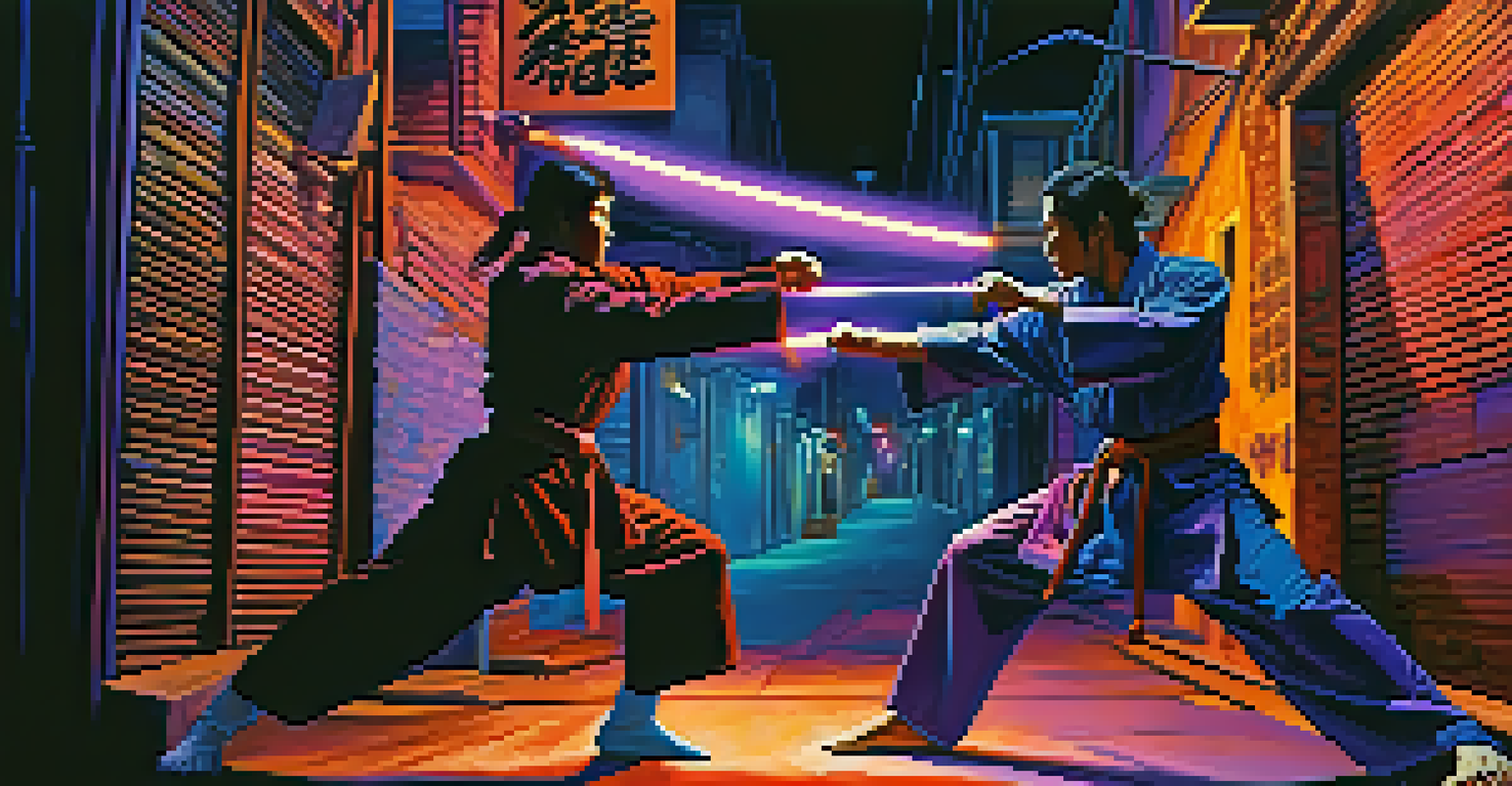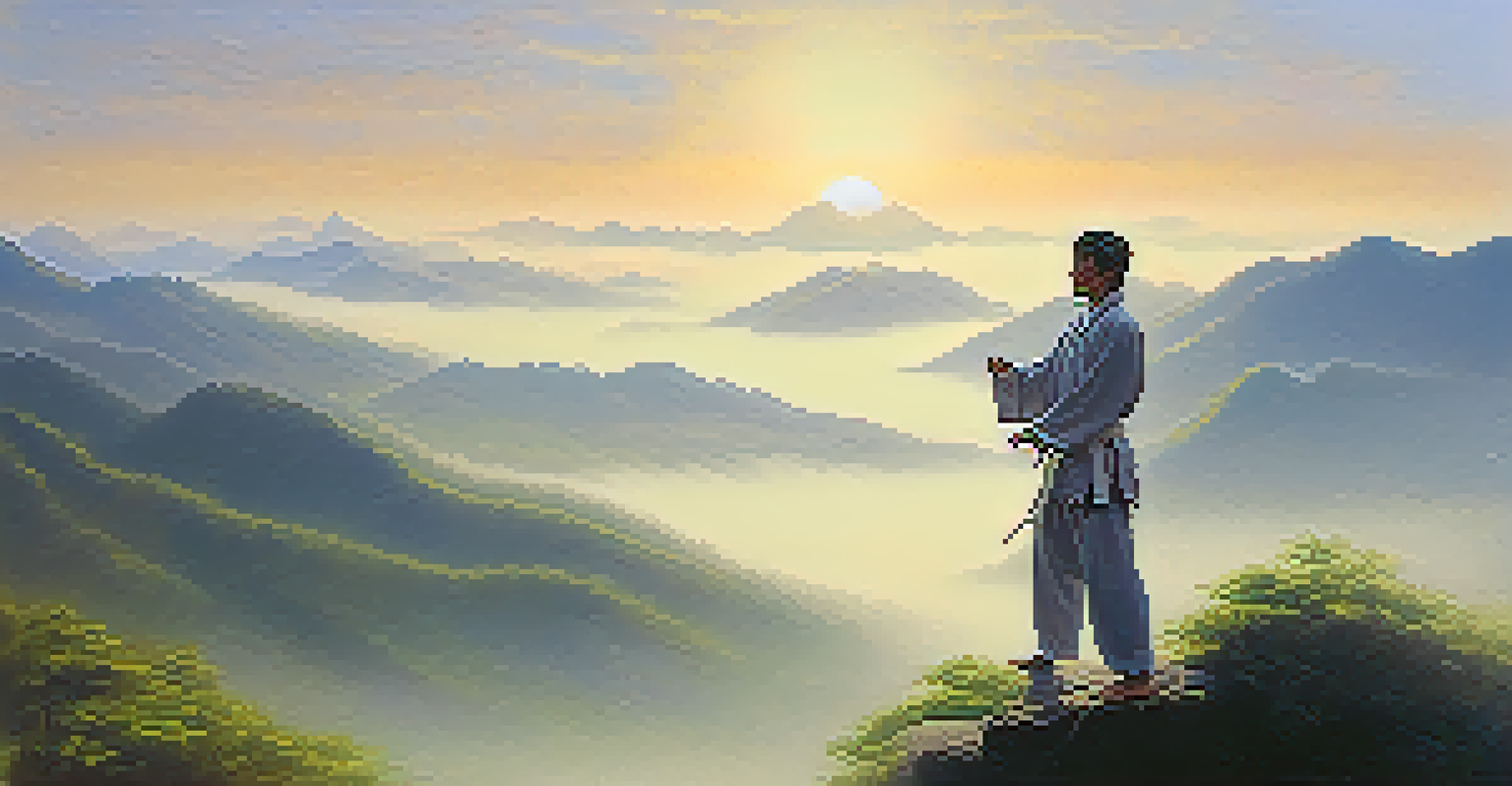Cinematic Techniques: Capturing Martial Arts on Screen

Understanding the Essence of Martial Arts in Film
Martial arts films are more than just fight scenes; they capture a deep cultural essence. From the fluid motion of a kung fu master to the explosive energy of a karate showdown, these elements tell a story. Filmmakers aim to convey the philosophy behind martial arts, showcasing discipline, honor, and the journey of the characters involved. By understanding this essence, creators can enhance their storytelling through movement and choreography.
Martial arts is not about the techniques, but about the philosophy behind them.
To effectively portray martial arts, directors often collaborate closely with choreographers who specialize in these forms. This partnership ensures that fight sequences feel authentic and resonate with viewers. For instance, the iconic fight scenes in films like 'Crouching Tiger, Hidden Dragon' not only showcase incredible skill but also illustrate the characters' emotional struggles. This blend of artistry and action is what elevates martial arts films to an art form.
Moreover, the cultural significance of martial arts cannot be overlooked. Each style carries its own history and traditions, which can add depth to a film's narrative. By weaving these cultural elements into the storyline, filmmakers can create a richer, more engaging experience for audiences, helping them connect with the characters on a deeper level.
Choreography: The Dance of Combat
Choreography is the backbone of any martial arts film, turning combat into a captivating dance. Each movement must be meticulously planned to ensure that it flows seamlessly from one action to the next. This requires not just physical skill but also a creative vision to portray the story through movement. For example, in 'The Matrix,' the choreography blends martial arts with acrobatics, creating an unforgettable visual experience.

A successful fight scene should tell a story of its own, revealing character motivations and emotions through physicality. The choreography should reflect the personalities of the fighters and the stakes of the conflict. A slow, deliberate fight can indicate a struggle with inner conflict, while a fast-paced brawl might highlight urgency and desperation. This storytelling aspect is what keeps viewers engaged and invested in the outcome.
Martial Arts: More Than Fights
Martial arts films convey deep cultural essence, showcasing discipline, honor, and character journeys through movement and choreography.
Additionally, the use of space is vital in choreographing a fight scene. Directors often consider the environment where the combat takes place, whether it’s a narrow alley or a wide-open arena. This spatial awareness can influence the choreography, allowing for creative use of surroundings that enhances the visual impact of the fight, making it feel more dynamic and immersive.
Camera Techniques: Framing the Action
Camera work plays a crucial role in how martial arts are captured on screen. The right angles and movements can amplify the intensity of a fight scene, drawing viewers into the action. For instance, a low-angle shot can make a fighter appear more powerful, while a high-angle shot can depict vulnerability. These choices help to establish the emotional tone of the scene, influencing how the audience perceives each character.
In martial arts, every move has a purpose, and every fight tells a story.
Moreover, the use of close-ups can highlight the physicality of martial arts, showcasing the strain on a fighter's face or the precision of a strike. This technique adds a layer of intimacy, allowing viewers to connect with the characters on a personal level. In films like 'Ong-Bak,' close-ups of the protagonist's expressions during intense moments create a gripping narrative that resonates with audiences.
Additionally, dynamic camera movements, such as tracking shots or whip pans, can enhance the fluidity of martial arts choreography. These techniques not only maintain the pace of the film but also create a visceral experience for viewers. By immersing the audience in the action, directors can make them feel as though they are part of the fight, heightening the overall impact of the scene.
Editing: The Rhythm of the Fight
Editing is where the magic happens, as it dictates the rhythm and pacing of a martial arts scene. Quick cuts can create a sense of urgency and adrenaline, while longer takes allow viewers to appreciate the skill and artistry of the choreography. The editor’s role is to balance these elements, ensuring that each moment builds tension and keeps the audience engaged.
For example, in 'Kill Bill,' director Quentin Tarantino uses sharp cuts to heighten the intensity of the fight scenes, creating a chaotic yet thrilling viewing experience. This technique not only maintains the momentum of the action but also emphasizes the emotional stakes involved. The rapid editing mirrors the frenzied energy of the battles, making the audience feel the weight of every blow.
Choreography Tells a Story
Meticulously planned choreography transforms combat into a captivating dance, revealing character motivations and emotions.
Moreover, sound design is intricately tied to editing, as the timing of sound effects can enhance the impact of each strike. The clash of fists, the whoosh of a kick, and even the character's grunts all contribute to the overall feel of the scene. By synchronizing these audio elements with visual cuts, editors can create a more immersive experience that resonates with viewers long after the credits roll.
Lighting: Setting the Mood for Combat
Lighting is an essential cinematic technique that can dramatically alter the mood of a martial arts scene. Different lighting styles can evoke various emotions, from the stark brightness of a training montage to the moody shadows of a climactic battle. For instance, high-contrast lighting can emphasize the drama of a fight, highlighting the tension between characters as they clash.
In films like 'Hero,' the use of color and lighting not only enhances the visual aesthetics but also reflects the emotional undertones of the narrative. Each fight is bathed in different hues, corresponding to the themes of loyalty, betrayal, and sacrifice. This strategic use of lighting helps to elevate the storytelling, making each battle feel significant and impactful.
Furthermore, the interplay of light and shadow can create visual depth, adding layers to the choreography. Shadows can obscure movements, creating an element of mystery, while bright lighting can reveal every detail of a fighter's technique. This careful manipulation of lighting allows filmmakers to craft a unique visual language that resonates with the audience, immersing them in the martial arts experience.
Sound Design: Amplifying the Impact of Action
Sound design is a powerful tool in martial arts filmmaking, amplifying the impact of each punch, kick, and movement. The right sound effects can turn a simple strike into an explosive moment, making the audience feel the weight of the action. This is particularly evident in films like 'Enter the Dragon,' where the sound of Bruce Lee's hits resonates with intensity, drawing viewers deeper into the fight.
Moreover, the use of music can elevate a scene, enhancing the emotional stakes of the conflict. A powerful score can build tension leading up to a fight, making the eventual clash all the more satisfying. The right musical cues can evoke excitement, fear, or even nostalgia, creating a visceral connection between the audience and the characters' journeys.
Future of Martial Arts Filmmaking
Advancements in technology and a focus on authentic representation are shaping a promising future for martial arts filmmaking.
Additionally, silence can be just as impactful as sound. In moments of high tension, the absence of noise can create a sense of anticipation, forcing the audience to lean in and focus on the action. This technique allows viewers to soak in the details of the choreography, making every movement feel significant. By carefully balancing sound and silence, filmmakers can craft a more engaging and immersive martial arts experience.
The Future of Martial Arts Filmmaking
As technology continues to advance, the future of martial arts filmmaking looks promising. Innovations in CGI and motion capture are allowing filmmakers to push the boundaries of what’s possible on screen. This technology can create breathtaking visuals that enhance traditional martial arts choreography, making the impossible seem possible. Imagine a fighter soaring through the air in a way that defies gravity, all while maintaining the authenticity of martial arts techniques.
Moreover, the rise of streaming platforms has opened new avenues for martial arts films, allowing for a wider variety of stories to be told. Filmmakers can explore lesser-known styles and cultural narratives, enriching the genre as a whole. This shift also allows for more niche audiences to engage with martial arts cinema, creating a more diverse landscape of storytelling.

Finally, as audiences become more global, there's a growing appreciation for authentic representation in martial arts films. Filmmakers are increasingly prioritizing cultural accuracy, collaborating with martial artists from different backgrounds to ensure that the stories being told are genuine. This commitment to authenticity not only enriches the films but also helps to educate viewers about the rich tapestry of martial arts traditions around the world.